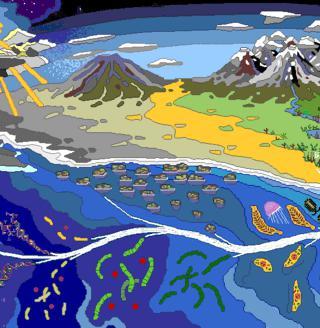If we think deeply about evolution, we eventually will ask questions not about the origin of species but about the origin of life. For some theistic evolutionists, this is the point of Designer intervention. They find it hard to imagine that chemicals could combine in way that gives rise to life. For those less inclined to invoke a deus ex machina, the problem may be difficult but is not intractable. There are several plausible hypotheses surrounding the origin of life.
Work in this field began with Aleksandr Oparin (1894-1980), a renowned Soviet biochemist who postulated that a young and cooling earth possessed a strongly reducing atmosphere containing methane, ammonia, hydrogen, and water vapor. Oparin asserted that these were the raw materials for the evolution of “life” (like many biochemists, Oparin rejected any strict separation between life and non-life). Over time, and with energy inputs from lightning, magma, and radiation, chemicals can combine in ways that led to colloidal enlargement, stability, and perhaps even replication.
Although Oparin never conducted experiments along the lines he suggested in Origin of Life (1938), his ideas were championed by Harold Urey, a Nobel Prize winning chemist at the University of Chicago. In 1952, Urey published “On the Early Chemical History of the Earth and the Origin of Life,” in which he offered explanations for the initial formation of organic compounds and suggested experiments involving methane, ammonia, hydrogen, water and an electrical charge (simulating lightning).
It was not long before one of Urey’s graduate students, Stanley Miller, conducted an experiment mimicking the hypothesized conditions of early earth. Miller built a laboratory apparatus containing a mixture of water, hydrogen, ammonia and methane, all of which were early earth ingredients. He then introduced electricity (“lightning”) in the form of 60,000 volt sparks, and trapped the resulting gases in a filter. When he analyzed the contents, Miller found that the molecules had combined into new and larger configurations. Four such configurations were amino acids, which are constituent components of proteins. The Miller-Urey experiments were widely accepted as a model of prebiotic synthesis.
Subsequent electrical-discharge experiments by prebiotic researchers have produced additional amino acids, and remarkably, the constituent elements of both RNA and DNA. Oro and Kimball synthesized adenine from hydrogen cyanide and ammonia. Sanchez and colleagues synthesized cyanoacetylene, a source for the pyrimidine bases uracil and cytosine, from a mixture of methane and nitrogen. Research into prebiotic chemistry continues unabated, with an ever increasing variety of precursor organics being produced in the laboratory, and multiple pathways to the formation of RNA and DNA being suggested. The long and short of all this research is that there are many plausible chemical paths to the formation of things that contain RNA/DNA and which produce proteins.

Plausible is not, however, either probable or provable and the gap from there to here is, even today, immense. This gap is fraught with difficulty, perhaps none more so than the issue of replication. Two of the primary issues surrounding replication are metabolism and autcatalysis. Self-sustaining chemical reactions are unusual, requiring both energy sources and catalytic enzymes. When all prebiotic combinations and conditions are considered together, the emerging consensus revolves around three scenarios: (1) synthesis in a reducing atmosphere; (2) organic inputs from meteorites or comets; and (3) synthesis of metal sulfides in deep sea vents.
What all these hypotheses all have in common is a strictly material, physical and chemical cause resulting in a molecule that replicates itself. This replicating molecule, composed of sugar, phosphate and five acid bases, is uniquely vital: “A fundamental property of living systems is that they have a chemical basis for storage of genetic information. RNA, DNA and other nucleic-acid-like compounds are informational macromolecules that have inherent template properties and so lend themselves in a straightforward way to both storing information and replicating it.”
Given the pace and innovation of research into origins, it seems just a matter of time before life is produced in a laboratory. When that happens, the Designer will be pushed back even further in time, with the Big Bang being the obvious point of retreat.
Reference:
Urey, Harold. (1952). On the Early Chemical History of the Earth and the Origin of Life Proceedings of the National Academy of Sciences, 38 (4), 351-363 DOI: 10.1073/pnas.38.4.351
Peretó J (2005). Controversies on the origin of life. International microbiology : the official journal of the Spanish Society for Microbiology, 8 (1), 23-31 PMID: 15906258
Joyce, G. (1989). RNA evolution and the origins of life Nature, 338 (6212), 217-224 DOI: 10.1038/338217a0
Orgel LE (1998). The origin of life–a review of facts and speculations. Trends in biochemical sciences, 23 (12), 491-5 PMID: 9868373



